Hardware - Tablet
You might have recognized that we mentioned
a lot about the new PadFone in our first hands-on, but let us summarize: this
module is basically is a 10.1inch, 1,280x800 external IPS LCD screen for
PadFone 2, but it also simultaneously plays the role of the 3.8V,5000mAh (19Wh)
battery. It is a little bit smaller than the 24.4Wh battery in the first
PadFone Station, but just bear in mind that the PadFone 2 does now own a larger
battery. All of them add up to 27Wh, which is not much different from the old
30Wh one. Moreover, what is more important is the weight reduction that Asus
has achieved successfully with the slimmer PadFone Station: from 724g down to
514g. That is a 30 percent reduction! In other words, the combination with the
135g is still lighter than the first generation iPad alone (652g). In contrary,
the original PadFone 2 together with the PadFone Station is heavier than the
first generation iPad, which made people hard to believe in the “N+1” concept
of Asus.

The
tablet
With the smaller battery, the removal of
the battery LED indicator and the new 13-pin MHL socket at the bottom (which
because of some reasons is up-side down compared to that of PadFone 2) of
course helps achieving the lighter weight. However, we are also informed that
every component is carefully considered to see whether it is possible to reduce
any other weight. Those that contribute mainly on the weight reduction are
surely the obscure Corning Fit Glass (on the phone as well as the tablet), the
magnesium-aluminum alloy frame and the method of cover-less docking. The
interesting thing is that Asus has been working on the docking mechanism for a
year and a half, which confirms our assumption that two PadFone have been
developed together at that time. We remember the time that we interviewed
Michelle Hsiao from the Asus’s design center, there were any PadFone Station
models with understandable slide-in docking methods, but Hsiao said that they
could not come up with any method that ensured secure docking for the exposed
phone, so they had to accept the bulkier solution.
So how does the new docking mechanism work?
Of course, there is the new 13-pin MHL (which the old PadFone cannot be compatible
with), but that single thing is not enough to secure the phone safely in the
bay, and “safely” in our statement means that strong enough to secure the phone
through powerful shake. This is where a cute component locates: instead of
using the typical slide-lock mechanism, Asus came up with the idea of a system
that pushes four toothed, rubber pads – whose material is similar to that of
the bike brake pads – on two sides of the phone whenever it is inserted in. You
will hear a light click when the phone reaches the bottom of the bay, and it
usually takes about 1 second – instead of 2 on the original PadFone – for the
tablet’s interface to recognize.
Just like what you can see in our
instruction video, the phone stands still inside the bay when we strongly shake
the upside-down tablet (please do not try this at home), Then it becomes more
attractive when you recognize how easy it is to insert and remove the phone –
as if the mechanism was just working once you shook the device. To discover
whether there is any magic inside, we ripped the device open, but until we had
the specific devices, the secret of waiting for the patent of Asus still
remained safe. However, in later time, we tried another shake and the phone
slid out in the end, and we thought of dust or some kind of powder sticking to
the rubber pads as the reasons for this, so be careful.

The
typical slide-lock mechanism
There is no other thing that is visible on
the new PadFone Station except for a 1MP camera at the regular location, as
well as the power button and volue rocker around the top left corner – none of
which is easily pressed accidentally. If we have to be nitpicky, the only
complaint is that the phone is not lying flatly with the back side’s surface of
the device, which means if we lay the device on a table, the tablet would be
wobble if you tap on neither of the side too strongly – we are thinking of the
case when users are typing or playing some particular games. Hopefully, the
dedicated PadFone 2 Station sleeve can manage this problem. While using it, we
can hold the new PadFone Station much longer thanks to the combination of
curved edges, so we prefer to hold the tablet on the top edge with the top of
the phone contacting our hand. We just need to remember to clean the camera
lens before taking any picture.
So what about the docking keyboard? Inspite
of the “confirmed” reports stating that a new dedicated docking keyboard is in
the working progress, Asus woke our dreams by saying that all of these things
are not true. We worried – it is sure that you will have a Bluetooth keyboard
or a plug-in USB keyboard via an OTG dongle, but it is not as aesthetic as
folding everything into a netbook form – which we were able to do with the
original PadFone, despite the total weight of 1.49kg. Hopefully, Asus will
admit their failure at last and launch a relevant hinged keyboard dock, because
it will concentrates on the main point of using Android to increase the
productivity.

The
only complaint is that the phone is not lying flatly with the back side’s
surface of the device
Some people desired to see the PadFone
Infinity, which was equivalent to the 10.1 inch tablet module coming with a
1080p panel. We raised the question to Asus that whether they intend to
introduce such upgrade, and their answer was while it was able to launch a
1080p from a phone or a tablet, the manufacturer kept the same resolution for
both of the display on purpose because of the possibility of easier app and
video rescaling, and therefore helped saving the processing power and battery
life. In other words, it is not the suitable time, or it is also possible that
Asus is just putting on a poker face.